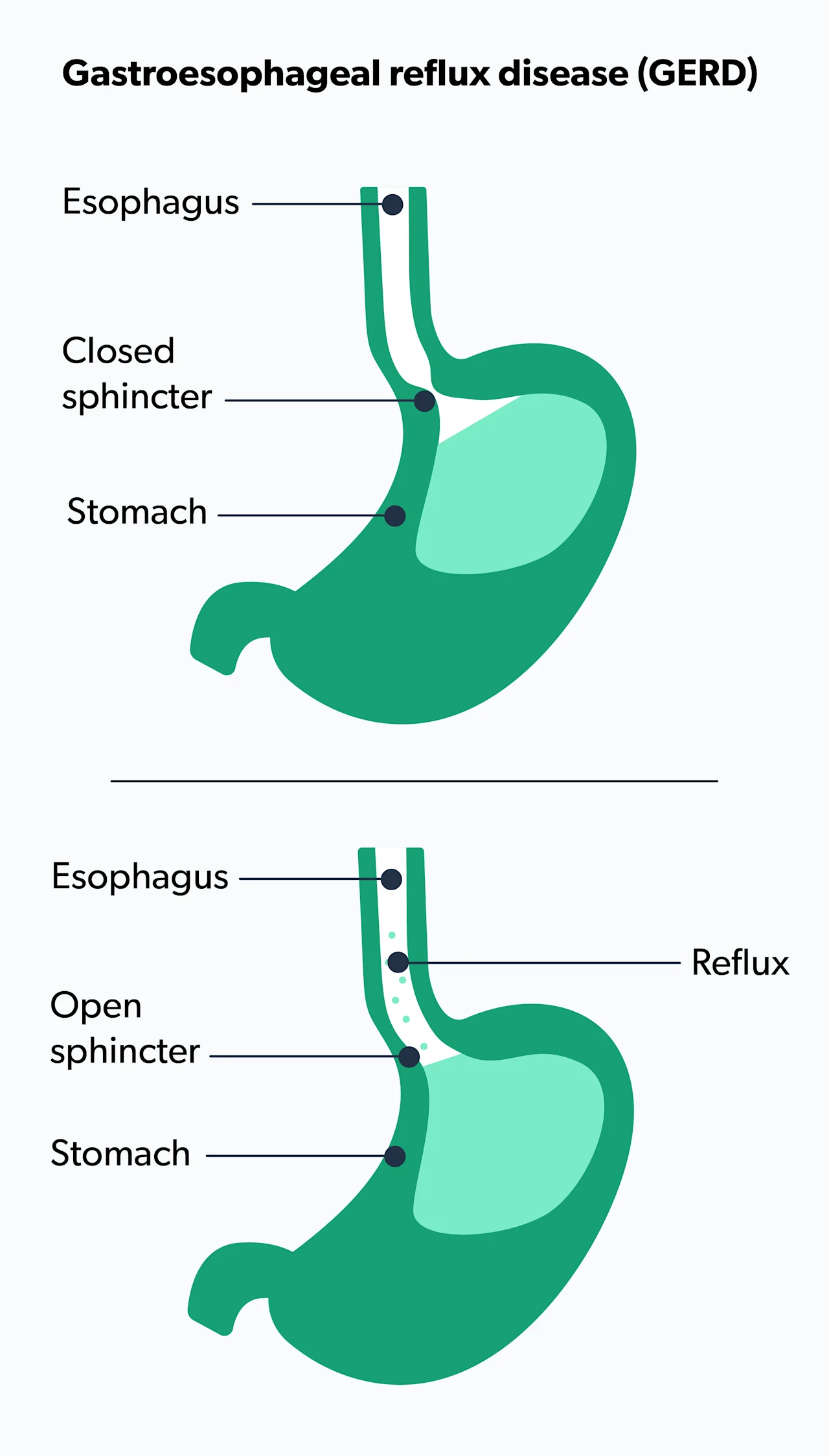Pantoprazole interactions to know about before you take it

Reviewed by Yael Cooperman, MD, Ro,
Written by Alexandria Bachert
last updated: Nov 06, 2020
6 min read
Here's what we'll cover
If you’re reading this article, you might be considering pantoprazole (brand name Protonix) to help you find some relief from heartburn, acid reflux, or other discomfort. Part of a class of drugs called proton pump inhibitors (PPIs), pantoprazole is commonly used to reduce the amount of acid in your stomach.
Pantoprazole is prescribed to treat gastroesophageal reflux disease (GERD), as well as peptic ulcer disease and a rare condition called Zollinger-Ellison syndrome (DailyMed, n.d.). Proton pump inhibitors are generally well-tolerated, but we’ve got everything you need to know about the common side effects and drug interactions that have been linked to pantoprazole.
Pantoprazole interactions
A 2000 review of PPIs found that pantoprazole is as effective as other PPIs, but with a low likelihood of drug interactions (Jungnickel, 2000). However, pantoprazole can still affect the way your body processes certain vitamins, medications, and alcohol.
Pantoprazole and absorption of vitamins and medications
PPIs like pantoprazole work to reduce the amount of stomach acid your body makes, alleviating acid reflux and symptoms like heartburn. Sometimes, however, the reduced levels of stomach acid can make it difficult for your body to absorb certain nutrients and medications.
One problem is magnesium deficiency. This typically only occurs in people taking PPIs for more than three months and can result in muscle spasms or cramps, as well as weakness. Less frequently, people taking pantoprazole for more than two years can develop a vitamin B12 deficiency. Your healthcare provider can check your levels of B12 with a simple blood test and recommend supplements if necessary (UpToDate, n.d.).
Pantoprazole and alcohol
Alcohol does not interfere with the way pantoprazole works, but you should still be mindful of your consumption.
At certain concentrations, alcohol has been shown to increase the production of gastric acid in the stomach, which can irritate your stomach lining and exacerbate existing symptoms. Some research suggests that beverages with lower alcohol content (5% alcohol by volume) like beer and wine are more likely to increase stomach acid production than beverages with a higher concentration, including gin and whisky (Chari, 1993).
Additionally, drinking too much or too often can irritate your stomach lining and exacerbate underlying symptoms and conditions, such as heartburn and stomach ulcers (Malik, 2020).
If you’re taking pantoprazole for any of the conditions mentioned in this article, you might want to consider abstaining or drinking in moderation.
Pantoprazole side effects
For some people, taking pantoprazole may result in side effects—the most frequent being headaches. Other common side effects include (DailyMed, n.d):
Diarrhea
Nausea
Abdominal pain
Gas
Dizziness
Muscle pain
High doses and long-term use of pantoprazole can also increase the risk of osteoporosis and bone fractures of the hip, wrist, or spine. If you’re over 50-years-old and are taking pantoprazole, you might consider speaking with your healthcare provider about ways to strengthen your bones (DailyMed, n.d).
Long-term use of PPIs like pantoprazole can affect the delicate balance of bacteria in the digestive system and lead to Clostridium difficile (C. diff), a bacterial infection that can result in persistent diarrhea (FDA, 2017). The FDA advises people to seek immediate care if they use PPIs and develop diarrhea that does not improve.
In rare cases, PPIs can cause a rare hypersensitivity reaction known as acute interstitial nephritis, which affects the kidneys. Symptoms can include nausea, vomiting, and reduced urination. Pantoprazole can also pose an increased risk for new or worsening symptoms of lupus, so tell your healthcare provider if you experience joint pain or a skin rash on your cheeks or arms that worsens in sunlight (DailyMed, n.d).
What are proton pump inhibitors?
As mentioned earlier in the article, PPIs—such as pantoprazole (brand name Protonix), omeprazole (brand name Prilosec), and lansoprazole (brand name Prevacid)—halt the production of gastric acid in your stomach, effectively reducing the amount of acid and preventing or alleviating symptoms (Wolfe, 2020).
What is pantoprazole used for?
Pantoprazole and other PPIs are frequently used to treat (Wolfe, 2020):
Acid reflux
Gastroesophageal reflux disease (GERD)
Peptic ulcer disease (PUD)
What is acid reflux?
Acid reflux is a common medical condition that occurs when your stomach contents flow back into your esophagus (the tube that runs from the throat to the stomach). Reflux can occur once in a while or with greater frequency and can cause symptoms such as heartburn, a sour taste in the mouth, nausea, and even cough.
Not sure what heartburn feels like? Most people describe it as a burning chest pain behind the breast bone that travels up through the neck and throat. It may even feel like your food is moving back up through the esophagus and throat, leaving a bitter taste in your mouth.
According to the American College of Gastroenterology, more than 60 million Americans experience heartburn at least once per month, and as many as 15 million Americans experience heartburn symptoms each day (ACG, n.d.)
What is GERD?
Although acid reflux and gastroesophageal reflux disease (GERD) are sometimes used interchangeably, there’s a significant difference. GERD is a chronic, more severe form of acid reflux and is diagnosed when acid reflux occurs more than twice a week.
GERD is quite common in the United States, affecting approximately 18-28% of people in North America. Some of the leading risk factors of GERD include excessive body mass index (BMI), anxiety, smoking, and being sedentary at work. Eating habits, such as the timing and size of meals, may also contribute to the development of the condition (Clarrett, 2018).
Some of the most common symptoms of GERD can include (Vakil, 2006):
Heartburn
Regurgitation (when the food rises back up into your throat)
A sour taste in your mouth, especially after lying down or when you wake up in the morning
Less commonly, GERD can cause bloody coughs, bloody stool, iron-deficiency anemia, weight loss, or difficulty swallowing. If you experience any of these symptoms, schedule some time with your healthcare provider for a more thorough investigation (Vakil, 2006).
While you might think of acid reflux as just a bother when it happens a lot, it can be dangerous and something to keep an eye on. When left untreated, GERD can lead to conditions such as Barrett’s esophagus—in which the esophagus faces repeated exposure to stomach acid, which can damage the cells (Clarrett, 2018).

Medication
As explained earlier, heartburn is pretty common, and occasional episodes following meals aren’t usually anything to be concerned about.
Heartburn often occurs due to diet and lifestyle choices and can be managed by losing weight, cutting out smoking, eating fewer fatty foods, and avoiding overly spicy or acidic foods.
When the heartburn is a symptom of a more severe problem like acid reflux or GERD, your healthcare provider may suggest treatment involving a PPI like pantoprazole. If your heartburn becomes frequent or uncomfortable, speak with your healthcare provider to discuss an evaluation using an upper endoscopy and a barium swallow test.
What is peptic ulcer disease?
Peptic ulcer disease (PUD) is when painful sores develop in the lining of the stomach or the first part of the small intestine (duodenum). PUD typically occurs for two reasons (AGA, n.d.):
An infection in the stomach lining caused by a bacteria called Helicobacter pylori (H. pylori)
Overuse of nonsteroidal anti-inflammatory drugs (NSAIDs)—such as ibuprofen (brand names Advil and Motrin) and aspirin. NSAIDs are used to alleviate aches, pains, and swelling.
Although unpleasant, there are ways to help decrease your chances of developing these ulcers. For example, spicy food won’t cause gastric ulcers but can exacerbate symptoms and discomfort. Stress, however, can indeed contribute to the development of ulcers (Lee, 2017).
PUD symptoms may vary but often include abdominal pain, upset stomach, loss of appetite, vomiting, and weight loss (Narayanan, 2018). Other times, people may have peptic ulcer disease but not the symptoms. In fact, up to 70% of cases may be entirely asymptomatic (Lu, 2004).
In cases without the obvious symptoms, your healthcare provider might only suspect PUD if you present black or bloody stool or low iron levels in your blood (Vakil, 2020). Also known as iron-deficiency anemia, low iron levels are often seen in those with a nutrient-deficient diet, pregnant women, and older individuals with blood loss (Warner, 2020).
Medication
If you’re experiencing any of the symptoms mentioned above, meet with your healthcare provider to discuss treatment for PUD.
Your healthcare provider might conduct a simple breath test called the urea breath test or check your stool for the bacteria to understand if your PUD is caused by a H. pylori infection (Crowe, 2020).
Treatment for H. pylori typically lasts 10–14 days and involves the use of two types of antibiotics and a PPI like pantoprazole. This combination will help alleviate the discomfort and clear the infection (Chiba, 2013). While your symptoms may improve before you finish the full course of treatment, it’s very important to follow your healthcare provider’s instructions to ensure that the infection is treated completely and to reduce the likelihood that it will return (Crowe, 2020).
If it’s determined that NSAIDs are responsible for your peptic ulcers, your healthcare provider will advise you to stop the medication and find an alternative option if possible. This treatment will also likely include the use of PPIs to alleviate the symptoms and allow the ulcers to heal (Vakil, 2020).
Protonix over-the-counter (OTC)
Protonix (pantoprazole sodium) received FDA approval in 2000 for the short-term treatment of the following conditions (FDA, 2012):
Erosive esophagitis (esophagus inflammation) associated with GERD
The maintenance of healing of erosive esophagitis
Pantoprazole also comes with a variety of off-label uses, including the prevention of peptic ulcer disease and NSAID-induced ulcers, as well as to eradicate Helicobacter pylori bacteria (Bernshteyn, 2020).
Protonix is available in delayed-release tablets at 20 mg and 40 mg. Liquid pantoprazole, 40 mg, can also be prescribed for people who have difficulty swallowing tablets. The tablets should be swallowed whole with or without food, and the oral medicine is usually administered with applesauce or apple juice approximately 30 minutes prior to a meal. You can review the complete drug information here (FDA, 2012).
Protonix generic
If your healthcare provider determines that a PPI is the right treatment for you, they may prescribe Protonix or the generic version of the drug, Pantoprazol. Protonix and Pantoprazol are identical in usage and dosage.
DISCLAIMER
If you have any medical questions or concerns, please talk to your healthcare provider. The articles on Health Guide are underpinned by peer-reviewed research and information drawn from medical societies and governmental agencies. However, they are not a substitute for professional medical advice, diagnosis, or treatment.
American Gastroenterological Association (AGA). (n.d). Peptic ulcer disease. Retrieved Oct. 20, 2020 from https://gastro.org/practice-guidance/gi-patient-center/topic/peptic-ulcer-disease/
Bernshteyn, M.A. & Masood, U. (2020). Pantoprazole. StatPearls [Internet]. Retrieved Oct. 20, 2020 from https://www.ncbi.nlm.nih.gov/books/NBK499945/
Chari, S., Teyssen, S., & Singer, M. V. (1993). Alcohol and gastric acid secretion in humans. Gut, 34 (6): 843-847. doi:10.1136/gut.34.6.843. Retrieved from https://www.ncbi.nlm.nih.gov/pmc/articles/PMC1374273/
Chiba, T., Malfertheiner, P., & Satoh, H. (2013). Proton pump inhibitors: A balanced view. Gastrointestinal Research, 32 , 59-67. doi:10.1159/000350631. Retrieved from https://www.karger.com/Article/Abstract/350631
Clarrett, D. M. & Hachem, C. (2018). Gastroesophageal reflux disease (GERD). Missouri Medicine, 115 (3): 214-218. Retrieved from https://www.ncbi.nlm.nih.gov/pmc/articles/PMC6140167/
Crowe, S. E. (2020, January 09). UpToDate. Treatment regimens for Helicobacter pylori. Retrieved Oct. 20, 2020 from https://www.uptodate.com/contents/treatment-regimens-for-helicobacter-pylori?search=h.pylori
DailyMed. (n.d). PANTOPRAZOLE SODIUM- pantoprazole tablet, delayed release. Retrieved Oct. 20, 2020 from https://dailymed.nlm.nih.gov/dailymed/drugInfo.cfm?setid=f3ded82a-cf0d-4844-944a-75f9f9215ff0
Food and Drug administration (FDA). (2012). Protonix. Retrieved from https://www.accessdata.fda.gov/drugsatfda_docs/label/2012/020987s045lbl.pdf
Heinze, H. & Fischer, R. (2012). Lack of interaction between pantoprazole and ethanol. a randomised, double-blind, placebo-controlled study in healthy volunteers. Clinical Drug Investigation, 21, 345-351. doi:10.2165/00044011-200121050-00004. Retrieved from https://link.springer.com/article/10.2165/00044011-200121050-00004
Jungnickel, P.W. (2000). Pantoprazole: a new proton pump inhibitor. Clinical Therapeutics, 22 (11): 1268-1293. doi:10.1016/s0149-2918(00)83025-8. Retrieved from https://pubmed.ncbi.nlm.nih.gov/11117653/
Lee, Y. B., Yu, J., Choi, H. H., Jeon, B. S., Kim, H. K., Kim, S. W., et al. (2017). The association between peptic ulcer diseases and mental health problems: A population-based study: a STROBE compliant article. Medicine (Baltimore), 96 (34): e7828. doi.org/10.1097/MD.0000000000007828. Retrieved from https://www.ncbi.nlm.nih.gov/pmc/articles/PMC5572011/
Lu, C. L., Chang, S. S., Wang, S. S., Chang, F. Y., & Lee, S. D. (2004). Silent peptic ulcer disease: frequency, factors leading to "silence," and implications regarding the pathogenesis of visceral symptoms. Gastrointestinal Endoscopy, 60 (1): 34-38. doi: 10.1016/s0016-5107(04)01311-2. Retrieved from https://pubmed.ncbi.nlm.nih.gov/15229422/
Malik, T.F., Gnanapandithan, K., & Singh, K. (2020). Peptic ulcer disease. StatPearls [Internet]. Retrieved Oct. 20, 2020 from https://www.ncbi.nlm.nih.gov/books/NBK534792/
Narayanan, M., Reddy, K. M., & Marsicano, E. (2018). Peptic Ulcer Disease and Helicobacter pylori infection. Missouri Medicine, 115 (3): 219-224. Retrieved from https://www.ncbi.nlm.nih.gov/pmc/articles/PMC6140150/
National Institute of Diabetes and Digestive and Kidney Diseases (NIDDK). (2007). Heartburn, gastroesophageal reflux (GER), and gastroesophageal reflux disease (GERD). Retrieved Oct. 20, 2020 from http://sngastro.com/pdf/heartburn.pdf
UpToDate. (n.d.). Pantoprazole: Drug information. Retrieved Oct. 20, 2020 from https://www.uptodate.com/contents/pantoprazole-drug-information?search=pantoprazole
Vakil, N. B. (2020, April 1). UpToDate. Peptic ulcer disease: Treatment and secondary prevention. Retrieved Oct. 20, 2020 from https://www.uptodate.com/contents/peptic-ulcer-disease-treatment-and-secondary-prevention
Vakil, N., Zanten, S. V., Kahrilas, P., Dent, J., & Jones, R. (2006). The Montreal Definition and Classification of Gastroesophageal Reflux Disease: A Global Evidence-Based Consensus. The American Journal of Gastroenterology, 101 (8): 1900-1920. doi:10.1111/j.1572-0241.2006.00630. Retrieved from https://pubmed.ncbi.nlm.nih.gov/16928254/
Warner, M.J. & Kamran, M.T. (2020). Iron deficiency anemia. StatPearls [Internet]. Retrieved Oct. 20, 2020 from https://www.ncbi.nlm.nih.gov/books/NBK448065/
Wolfe, M. M. (2020, July 13). UpToDate. Proton pump inhibitors: Overview of use and adverse effects in the treatment of acid related disorders. Retrieved Oct. 20, 2020 from https://www.uptodate.com/contents/proton-pump-inhibitors-overview-of-use-and-adverse-effects-in-the-treatment-of-acid-related-disorders










